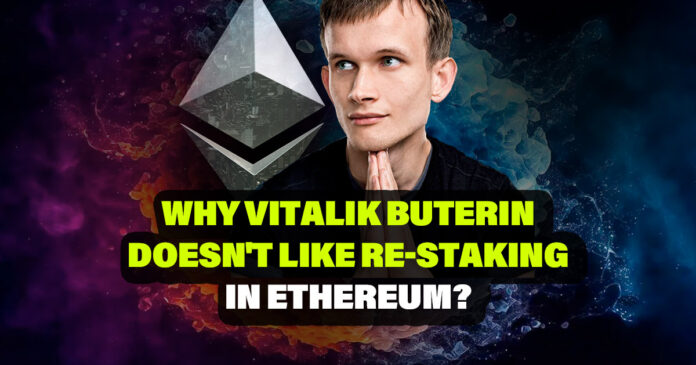Re-staking has been one of the recent developments in Ethereum, taking center stage. And the core idea behind this trend is: When you can rent a security system, why create your own?
Re-staking is a process where ETH tokens that are “staked” on Ethereum can be reused for smaller applications and networks. In this article, we’ll discover why Vitalik thinks this.
What is re-staking?
Despite the popularity of re-staking, Ethereum’s co-founder, Vitalik Buterin, is far from a big fan. The popular developer cited the risk of “centralization” as one of the drawbacks of re-staking. In addition, Buterin said he was concerned that re-staking might bring about risks that would jeopardize the network’s security.
Furthermore, he noted that trends such as re-staking can overcomplicate the Ethereum consensus mechanism beyond its main design. Buterin expressed concerns in a blog post about projects that could excessively increase risks in the Ethereum ecosystem. And complicate the roles of Ethereum validators outside their fundamental responsibility of validating the standards of the fundamental protocol.
Do not:
a) don’t build complex financial primitives on restaking – they can spiral out
b) don’t rely on Ethereum to fork for application layer errors – this is a super important principle
c) do not use subjective slashing – as it is subject to tyranny of the dishonest majority— Sreeram Kannan (@sreeramkannan) May 21, 2023
Buterin on the Risks Involved With Re-Staking
Furthermore, Buterin believes that re-staking can serve low-risk purposes. However, some circumstances can affect the main net’s security. This includes slashing validators for third-party claims. Slashing refers to the punishment given to validators who engage in illegal acts, such as processing transactions irregularly.
Buterin urged his followers to be “wary of application-layer projects taking actions that risk increasing the “scope” of blockchain consensus to anything other than verifying the core Ethereum protocol rules.”
🧩 Buterin's main concern is that re-staking could make the roles of Ethereum validators more complex than they need to be. Validators already have a crucial role in verifying the core protocol rules, adding more responsibilities could make their job more challenging. 7/9
— YFarmX 📈 (@YFarmX) June 12, 2023
He noted that such ideas are often approached without considering the possible risks. And they can become misaligned with the core community goal. Buterin added that such a process has no limiting principle. And that a blockchain community could easily become burdened with an increasing number of “mandates” over time if such a process were to take place.
Vitalik Buterin warns against overcomplicating Ethereum's consensus with re-staking mechanisms, emphasizing the need to preserve simplicity and security. Caution is necessary to prevent unnecessary risks and maintain the core role of Ethereum validators.https://t.co/wF0Q6VCMLf
— Francesco Trading Advisor (@FrancescoTradi2) May 29, 2023
This would force the community to make a difficult choice between a high yearly risk of splitting and some sort of de facto formalized bureaucracy that controls the chain in its entirety.
Buterin suggested that “we should instead preserve the chain’s minimalism and support uses of re-staking that do not seem like slippery slopes towards extending the role of Ethereum consensus.”




























